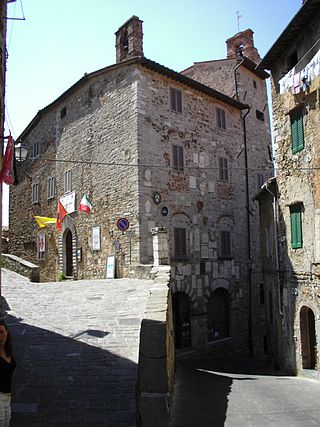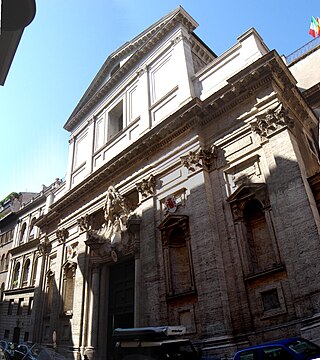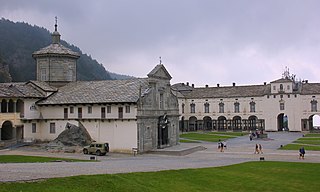
The Sanctuary of Saint Michael the Archangel is a Roman Catholic shrine on Mount Gargano, Italy, part of the commune of Monte Sant'Angelo, in the province of Foggia, northern Apulia. It has the dignity of a minor basilica.

The Church of the Gesù is the mother church of the Society of Jesus (Jesuits), a Catholic religious order. Officially named Chiesa del Santissimo Nome di Gesù, its façade is "the first truly baroque façade", introducing the baroque style into architecture. The church served as a model for innumerable Jesuit churches all over the world, especially in the central Europe and then in the Portuguese colonies. Its paintings in the nave, crossing, and side chapels became models for Jesuit churches throughout Italy and Europe, as well as those of other orders. The Church of the Gesù is located in the Piazza del Gesù in Rome.

Campiglia Marittima is a comune (municipality) in the Province of Livorno in the Italian region of Tuscany, located about 90 kilometres (56 mi) southwest of Florence and about 60 kilometres (37 mi) southeast of Livorno. It is one of I Borghi più belli d'Italia.

Acquafondata is a comune (municipality) in the province of Frosinone, in the Italian region of Lazio, located in the Monti della Meta area, about 130 kilometres (81 mi) southeast of Rome and about 50 kilometres (31 mi) east of Frosinone.

Genoa Cathedral or Metropolitan Cathedral of Saint Lawrence is a Roman Catholic cathedral in the Italian city of Genoa. It is dedicated to Saint Lawrence, and is the seat of the Archbishop of Genoa. The cathedral was consecrated by Pope Gelasius II in 1118 and was built between the twelfth century and the fourteenth century as fundamentally a medieval building, with some later additions. Secondary naves and side covers are of Romanesque style and the main facade is Gothic from the early thirteenth century, while capitals and columns with interior corridors date from the early fourteenth century. The bell tower and dome were built in the sixteenth century.

Sant'Anna dei Lombardi,, and also known as Santa Maria di Monte Oliveto, is an ancient church and convent located in piazza Monteoliveto in central Naples, Italy. Across Monteoliveto street from the Fountain in the square is the Renaissance palace of Orsini di Gravina.

The Spanish National Church of Santiago and Montserrat, known as Church of Holy Mary in Monserrat of the Spaniards is a Roman Catholic titulus church and National Church in Rome of Spain, dedicated to the Virgin of Montserrat. It is located in the Rione Regola, at the intersection of alleyway of Via della Barchetta and the narrow Via di Monserrato, with the facade on the latter street, about three blocks northwest of the Palazzo Farnese.

The Abbey of Saint Scholastica, also known as Subiaco Abbey, is located just outside the town of Subiaco in the Province of Rome, Region of Lazio, Italy; and is still an active Benedictine abbey, territorial abbey, first founded in the 6th century AD by Saint Benedict of Nursia. It was in one of the Subiaco caves that Benedict made his first hermitage. The monastery today gives its name to the Subiaco Congregation, a grouping of monasteries worldwide that makes up part of the Order of Saint Benedict.

The Divine Mercy Shrine in Kraków, Poland, is a Roman Catholic basilica dedicated to the Divine Mercy devotion, and is the resting place of Faustina Kowalska, canonised by the Catholic Church on 30 April 2000.

The Sacro Monte di Varese is one of the nine sacri monti in the Italian regions of Lombardy and Piedmont which were inscribed on the UNESCO list of World Heritage Sites in 2003. It has an altitude of 807 metres above sea level.

The Abbey of Santa Giustina is a 10th-century Benedictine abbey complex located in front of the Prato della Valle in central Padua, region of Veneto, Italy. Adjacent to the former monastery is the basilica church of Santa Giustina, initially built in the 6th century, but whose present form derives from a 17th-century reconstruction.

The San Carlone or Sancarlone or the Colossus of San Carlo Borromeo is a massive copper statue by Giovanni Battista Crespi, erected between 1614 and 1698, near Arona, Italy. It represents Charles Borromeo, a Catholic saint and former archbishop of Milan. According to sculptor Frédéric Auguste Bartholdi "The statue of St. Charles Borromeo is the first known example of a statue of repousse copper, worked with the hammer inside and outside, and freely supported on iron beams". Today, the complex is maintained by Milan's Biblioteca Ambrosiana.

The Sanctuary of Oropa is a group of Roman Catholic buildings and structures in Oropa, frazione of the municipality of Biella, Italy. It is located at a height of 1,159 metres in a small valley of the Alpi Biellesi.

The Church of Saint John the Baptist is a Catholic church in Ein Karem, Jerusalem, that belongs to the Franciscan order. It was built at the site where Saint John the Baptist is believed to have been born.

Chioggia Cathedral is the main place of worship in Chioggia, Italy, in the south of the Venetian Lagoon. It dates from 1627. The interior contains many interesting works of art.
The Sanctuary of Santa Maria di Galloro is a church located on the via Appia Nuova, near Ariccia on the road to Genzano di Roma, in the region of Lazio, in Italy.

The Path of Saint-Charles is an historical, artistic and devotional route which follows the travels of saint Charles Borromeo from Arona, his native town, and Viverone, where the path joins the Via Francigena.
The Sacro Monte di Graglia is one of the numerous devotional places around the Italian Alps and it houses the Santuario di Nostra Signora di Loreto, one of the four major sanctuaries of the Biellese territory. Set in the Valle Elvo at 690 m on the sea level, the sanctuary is built near the Lauretana water industry.

The Sacro Monte di Arona, devoted to Charles Borromeo, is part of the Sacri Monti built in the 16th and 17th centuries. It is located in the territory of the town of Arona, province of Novara, region of Piedmont, Italy.

The Sanctuary of the Virgin of Taburnus, also known as Sanctuary of Saint Mary of Mount Taburno, is a religious structure built at the end of the 15th century at the foot of Mount Taburno. It is located in the comune of Bucciano, in the province of Benevento of Southern Italy. For more than two hundred years it was used by Dominican friars.




















